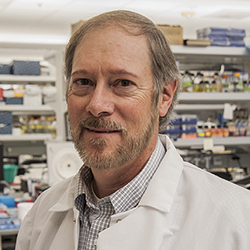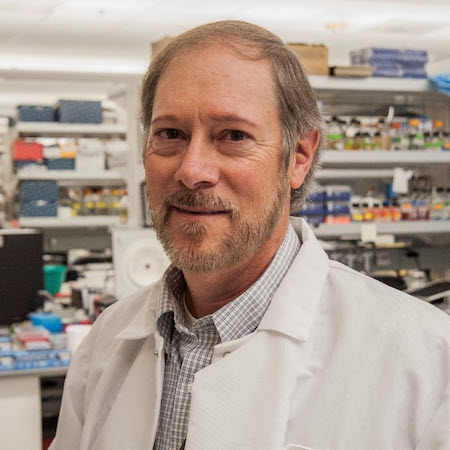Mark W Majesky, PhD

- Academic Title: Professor, Pediatrics
- Research Title: Director of Myocardial Regeneration Initiative; Principal Investigator
- Research Center: Center for Developmental Biology and Regenerative Medicine
"I love studying developmental biology and all its implications. It has enriched my life in many ways beyond my job. There is so much beauty in the field for me, and I get so excited when I learn about these biological mechanisms. I would study them even if they weren't part of my career. Knowing that it can have a tangible impact on children makes it worthwhile."
-
Biography
Mark began his research training at the University of Washington (UW) and now returns to the Pacific Northwest to join the Center for Developmental Biology and Regenerative Medicine to lead its groundbreaking program in stem cell biology and regenerative medicine as the director of the Myocardial Regeneration Initiative.
Dr. Majesky is a professor of pediatrics at the University of Washington and director of the Myocardial Regeneration Initiative at Seattle Children's Research Institute. The goal of this groundbreaking initiative is to understand the molecular mechanisms involved in the embryonic development of the heart and vascular system in order to discover and develop applications for stem and progenitor cell-based therapies. Eventually, Majesky hopes to lead a multidisciplinary team of experts in genetics, bioengineering, developmental biology, pathology and clinical pediatrics in translating discoveries made in the laboratory into therapeutic opportunities in the areas of congenital heart defects and other cardiac abnormalities. Additionally, he leads the stem cell research efforts for Seattle Children's Heart Center, where his work will benefit the heart failure program.
An internationally recognized expert in the field of stem cell biology, Majesky began his research career at the University of Washington and has held faculty positions at both Baylor College of Medicine in Houston and the University of North Carolina at Chapel Hill. He served as president of the North American Vascular Biology Association from 2008 to 2009 and in 2009 received the American Heart Association Special Recognition Award in Vascular Biology.
Research Description
Professional History
Graduate School:
University of Washington, Department of Pharmacology
Postdoctoral:
University of Washington, Vascular Biology
Faculty:
Assistant Professor, Baylor College of Medicine, Houston, TX
Associate Professor, Baylor College of Medicine, Houston, TX
Professor, University of North Carolina, Chapel Hill, NC
Molecular Basis of Coronary Vessel Development:
We study the development and differentiation of coronary blood vessels. Coronary progenitors are found in the proepicardium, a transient cell population that arises independently of the heart itself. In evolution, the appearance of the proepicardium correlates with the transition of the heart from a primitive tubular structure with a thin-walled, epithelial-type myocardium, as is found in pre- and early chordates, to a thick multilayered pumping organ found in most vertebrates.
Fate mapping studies show that proepicardial cells are the forerunners for the endothelium, smooth muscle and adventitial cells of the coronary vasculature. Formation of coronary vessels occurs by an epithelial to mesenchymal transformation (EMT) of proepicardial cells at the surface of the heart, followed by vasculogenesis in the subepicardial layer, assembly and remodeling of a primitive coronary plexus, and investment by coronary smooth muscle cells (CoSMCs).
We apply molecular biological and developmental genetic approaches to identify pathways for CoSMC commitment and differentiation during heart development. We use both chick and mouse models to explore mechanisms that couple proepicardial cell EMT and transcriptional activation of CoSMC target genes. Current projects in the lab employ transgenic and knockout mice to examine the role of sonic hedgehog signaling, rhoGTPase activation, and cytoskeletal remodeling in the stimulation of SRF and Tbxdependent transcription that mediates proepicardial cell differentiation to CoSMCs.
Role of Tbx18 in Murine Development:
T-box-containing proteins play critical roles as transcription factors that regulate cell fate and differentiation in development. Tbx18 is highly expressed in septum transversum and proepicardium. We used gene targeting in ES cells to produce Tbx18 knockout mice, which die shortly after birth with skeletal, renal and cardiac defects. Current projects aim to characterize these defects in detail, identify binding partners and gene targets for Tbx18, and prepare a conditional null allele for analysis of Tbx18 function in adult mice. Tbx18 is highly expressed in mesothelial membranes that line the pleural, pericardial and peritoneal cavities. These membranes are prone to fibrotic reactions to injury. Fibrosis limits regeneration and repair, restricts end organ function, and is an important cause failure in renal dialysis, and reproductive function after pelvic surgery. Adult models of mesothelial wound repair will allow us to genetically dissect key steps leading to pathological fibrosis.
Another goal of this project is to identify enhancer elements that direct Tbx18 expression to the proepicardium. Using rVISTA phylogenetic sequence comparisons, several conserved intronic elements have been identified as candidate proepicardial enhancers. These elements have been multimerized, ligated into minimal promoter vectors, and are being tested in transgenic frogs and mice.
Sonic Hedgehog Signaling and Adventitial Stem Cells
Blood vessels are continuously undergoing formation, regression, remodeling and repair throughout life. We found a domain of sonic hedgehog signaling restricted to the adventitial layer of artery walls which supports a population of resident vascular stem and progenitor cells. When removed from the adventitial niche environment, these resident progenitors differentiate to mural-like cells (pericytes and smooth muscle cells) in vitro, and closely associate with nascent microvessels in angiogenesis assays in vivo. Maintenance of an adventitial stem/progenitor cell phenotype is dependent upon expression of KLF4. The role of sonic hedgehog signaling in development of the adventitia is an active area of current investigation in the laboratory.Research Focus Area
Developmental Biology, Genetics, Stem Cell Biology
-
Related Resources
-
We use molecular biological and developmental genetic approaches to address fundamental questions in development and differentiation of blood vessels. Current projects use both mouse and avian models. One major research focus is on vascular stem and progenitor cells that reside in the adventitial layer of artery wall.
-
Mark W Majesky, PhD Researcher Profile
View the Seattle Children's Research Institute profile of Mark W Majesky, PhD including their publications and grants.
-
-
Patient Testimonials
-
Awards and Honors
Loading...Award Name Award Description Awarded By Award Date {{ award.name }} {{ award.description }} {{ award.organization }} {{ award.displayDate }} No Awards and Honors found for Mark W Majesky, PhD
-
Publications
Loading...No Publications found for Mark W Majesky, PhD
-
Presentations
Loading...Presentation Title Event Location Date {{ presentation.title }} {{ presentation.presentedAt }} {{ presentation.location }} {{ presentation.displayDate }} No Presentations found for Mark W Majesky, PhD
-
Research Funding
Loading...Grant Title Grantor Amount Award Date {{ funding.title }} {{ funding.grantedBy }} {{ funding.amount }} {{ funding.displayDate }} No Research Funding found for Mark W Majesky, PhD
-
Clinical Trials and Research Studies
Loading...{{ item.st }}
No clinical trials found for Mark W Majesky, PhD.
